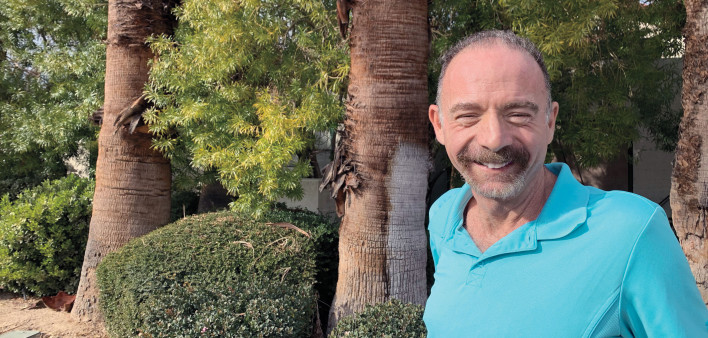For many people in the HIV community, the name Timothy Ray Brown is synonymous with hope. In 2008, when he was known as the Berlin Patient, Brown became the first person cured of HIV. In a 2011 POZ cover story, the resident of Palm Springs, California, went public with his identity and began advocating for HIV cure research, inspiring folks across the globe. He died in 2020 at age 54 of recurring cancer, but his legacy endures.
On World AIDS Day, observed December 1, Brown will be honored with a ceremony and the placement of a star on the Palm Springs Walk of Stars.
The ceremony will take place at 2:30 p.m., and the star will be placed near the future site of a planned Palm Springs AIDS memorial near Downtown Park, according to Desert Sun. Speakers will include HIV+ Aging Research Project executive director Jeff Taylor; Brown’s partner, Tim Hoeffgen; University of Southern California researcher Paula Cannon, PhD; and various city officials. To donate to the ongoing fundraising effort to cover the $15,000 cost of Brown’s star visit this GoFundMe.com account.
2nd Annual Timothy Rav Brown Community Cure Symposium Join us as we mark World AIDS Day in partnership with the...
Posted by HIV + Aging Research Project-Palm Springs on Monday, November 27, 2023
At 4:30 p.m. that same day, the HIV+ Aging Research Project will host the second annual Timothy Ray Brown Community Cure Symposium, where the keynote speaker will be Paul Edmonds, aka the City of Hope Patient, who was publicly declared cured of HIV in July 2022. You can register for the event via EventBrite.com.
This won’t be the first time Brown is honored with a memorial. A memorial boulder in his honor was unveiled at the National AIDS Memorial Grove in San Francisco’s Golden Gate Park in 2021. Also that year, a memorial bench and plaque were dedicated in Brown’s honor in Palm Springs.

The memorial boulder for Timothy Ray Brown at the AIDS Memorial Grove in San FranciscoLiz Highleyman

The memorial bench and plaque dedicated to Timothy Ray Brown on May 7, 2021, in Palm Springs, California.Jennifer Morton
To learn more about this inspiring HIV advocate, click #Timothy Ray Brown, where you can read his obituary and the 2011 POZ cover story. As the obituary explains:
An avid traveler, Brown was living in Berlin when he was diagnosed with HIV in 1995. He was on antiretroviral treatment with well-controlled HIV when he was diagnosed with acute myeloid leukemia in 2006, which would require two bone marrow transplants. His hematologist, Gero Hütter, MD, then at the University of Berlin’s Charité Hospital, had the idea to use stem cells from a donor with a rare genetic mutation known as CCR5-delta32 that blocks HIV from entering cells.
Brown underwent intensive chemotherapy and radiation to kill off his cancerous immune cells. He nearly died in the process and was left with lasting complications. But the donor stem cells rebuilt a new immune system that was resistant to the virus.
After the bone marrow transplants led to sustained HIV remission, Brown’s case was described in a poster at the 2008 Conference on Retroviruses and Opportunistic Infections (CROI) and written up in medical journals but received little attention outside the field.
Brown moved back to the United States in 2010, and in June 2011, he went public with his identity as the Berlin Patient in a POZ cover story.

Timothy Ray Brown on the June 2011 cover of POZ
In related news, click #World AIDS Day to learn more about this awareness day, including its history, this year’s theme and a calendar of events.







Comments
Comments